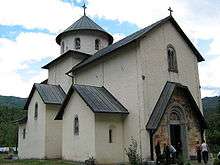Morača (monastery)
Morača Monastery (Montenegrin: Манастир Морача) is a Serbian Orthodox monastery located in the valley of the Morača River in Kolašin, central Montenegro. It was founded in 1252 by Stefan Vukanović, of the Nemanjić dynasty. It is one of the best known medieval monuments of Montenegro.
| Morača Морача | |
|---|---|
 | |
| Religion | |
| Affiliation | Serbian Orthodox Church |
| Ecclesiastical or organizational status | Metropolitanate of Montenegro and the Littoral |
| Location | |
| Location | Kolašin; In the valley of the Morača river, central Montenegro |
 Shown within Montenegro | |
| Geographic coordinates | 42.7661°N 19.3906°E |
| Architecture | |
| Architect(s) | Stefan Vukanović Nemanjić |
| Type | Byzantine (Ecclesiastical) |
| Style | Rascian style |
| Completed | 1252 |
History
The founding history is engraved above the western portal. Stefan, a son of Vukan Nemanjić, the Grand Prince of Zeta (r. 1190-1207; grandson of Stefan Nemanja), founded the monastery in 1252, possibly on his own lands (appanage).[1] The region was under the rule of the Nemanjić dynasty.[1]
The monastery was burned by the Ottomans for the first time in 1505, during a turbulent period of insurgency in Montenegro. The monks took shelter in Vasojevići. It was abandoned for the next seventy years. Thanks to a moderate political climate established by Sokollu Mehmed Pasha rebuilding started in 1574 and ended in 1580. Reconstruction itself was led by monks Tomo and Mojsije, and financially supported by the local population, especially knez Vukić Vučetić. [2] Vuk Stefanović Karadžić, a reformer of the Serbian language and collector of Serbian epic poems, recorded two poems regarding the Sack of Kolašin, in which in the beginning Novica Cerović and Serdar Milan drink wine together besides the white church in Morača.[3]
In July 1944, during World War II, a third session of the Yugoslav land assembly was held at the monastery, in which Montenegrin communists demanded that "the separate mention of the Bay of Kotor be excluded" (resulting in its incorporation into PR Montenegro).[4]
Architecture and art

The assembly church is a big one-nave building in the Rascian style[5] (The style spanned 1170-1300 and differs from the seaside churches), devoted to the Assumption of Mary, including a smaller church devoted to Saint Nicholas, as well as lodgings for travellers. The main door has a high wall which has two entrances, in the romantic style.
Beside the architecture, its frescoes are of special importance; the oldest fresco depicting eleven compositions from the life of the prophet Elias date to the 13th century, while the rest, of lesser condition, date to the 16th century. The 13th-century fresco shows conservative traits, with late-Comnenian figure-schemes, with architectural motifs of heavy and solid blocks, similar in manner to the frescoes of Sopoćani.[6] Out of the later frescoes, Paradise and the Bosom of Abraham and Satan on the Two-Headed Beast are notable Last Judgement depictions, dated to 1577-8.[7] The Ottoman Empire annexed the region in the first half of the 16th century, and the monastery was occupied and damaged, including most of the art.
References
- Fine 1994, p. 203
- =http://vremenskalinija.me/History%20of%20Montenegro%20T%20Line%206.html
- Chadwick, "The growth of literature, Volume 2" (), p. 427
- Banac, Ivo, "With Stalin against Tito: Cominformist splits in Yugoslav Communism" (), p. 104
- Mitchell 2010, p. 42
- Paul Atkins Underwood, "The Kariye Djami, Volume 1", p. 131
- John-Paul Himka, "Last Judgment iconography in the Carpathians" (2009), p. 40
Sources
- Fine, John Van Antwerp (1994), The Late Medieval Balkans: A Critical Survey from the Late Twelfth Century to the Ottoman Conquest, University of Michigan Press, ISBN 978-0-472-08260-5